Caballero B. (ed.) Encyclopaedia of Food Science, Food Technology and Nutrition. Ten-Volume Set
Подождите немного. Документ загружается.

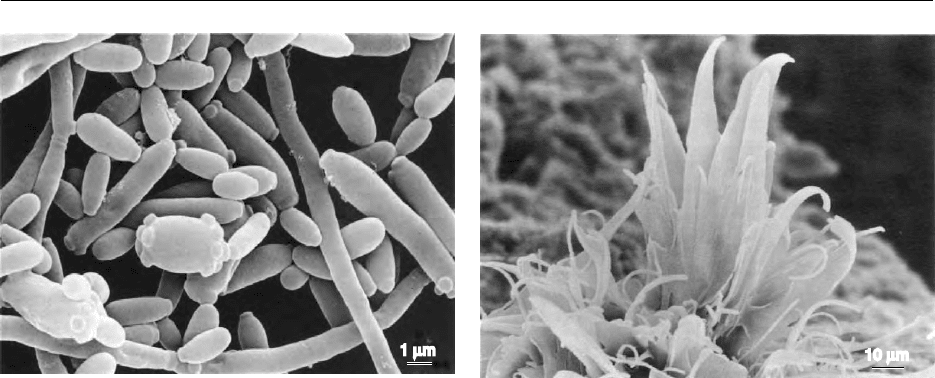
0011 In freeze-drying, wet samples are fast-frozen, trans-
ferred to a freeze-drying unit where a low tempera-
ture is maintained (typically 80
Cto90
C) and
the ice is sublimed slowly under low vacuum. Careful
control over the different stages, including initial
freezing, temperature, and vacuum of drying and, in
particular, of the rate of rewarming, has proved to be
important in retaining the microstructural features of
food materials.
0012 Unfortunately, these drying techniques are not
readily adaptable to fatty foods, because solvent
dehydration will remove the fat and freeze-drying
will not adequately stabilize it. Many investigators,
however, have found the techniques successful, for
example, in the study of foods containing carbo-
hydrate or protein gels and ‘fully biological’ tissues,
including meat, vegetable, and fruit.
Low-temperature SEM (Cryo-SEM)
0013 One way to overcome the problems of conventional
drying techniques is to make use of low-temperature
preparation procedures to examine frozen, fully
hydrated food materials. If the temperature of the
sample is sufficiently low (i.e., < 130
C), there
will be negligible freeze-drying in the vacuum
system of the SEM; typically, samples are held at
c. 170
C during imaging. No chemical fixation or
solvent dehydration needs to be involved as the
sample is ‘cryofixed’ (physically preserved). The tech-
nique has been used widely since the early 1980s in
various biological applications, including in the
examination of food.
0014The procedure involves rapid freezing of the speci-
men before transfer on to the precooled stage of a
cryopreparation unit, which may be either dedicated
(attached permanently to the SEM) or nondedicated
(free-standing) vacuum equipment. The sample is often
freeze-fractured in the unit to reveal internal structure.
When particularly high levels of water are present,
fractured and original surfaces can be ‘etched’ by rais-
ing the specimen temperature while it is still under
vacuum so that a thin layer of surface ice is sublimed
away to reveal more of the topographical detail.
0015As with low-temperature preparations for TEM, one
of the most crucial stages is in the initial freezing of the
specimen. It is desirable that the water present is solidi-
fied in a vitreous, noncrystalline state and the
remaining components are preserved in the same form
as they were originally. However, the relatively large
size of samples typically used for SEM prevents vitrifi-
cation of all but a very thin layer at the surface. In
practice, the aim of the freezing process is to render
the size of the resulting ice crystals as small as is prac-
ticable. Low-temperature SEM is particularly suitable
for examination of liquid or semisolid materials such as
margarines, low-fat spreads and dressings, as well as
foods with high levels of crystalline fat such as choc-
olate (Figure 2) and frozen foods such as icecream.
Auxiliary Techniques
X-ray Microanalysis
0016The principle of X-ray microanalysis is related to
the emission of X-rays from a specimen through
1 µm
fig0001 Figure 1 Spoilage yeast (Brettanomyces sp.) isolated from a
soft drink and prepared using critical-point drying. Bar ¼1 mm.
Reproduced from Microscopy: Scanning Electron Microscopy.
Encyclopaedia of Food Science, Food Technology and Nutrition,
Macrae R, Robinson RK and Sadler MJ (eds), 1993, Academic
Press.
10 µm
fig0002Figure 2 Fat bloom crystals (form VI) on the surface of a plain
chocolate bar examined using low-temperature scanning elec-
tron microscopy. Bar ¼10 mm. Reproduced from Microscopy:
Scanning Electron Microscopy. Encyclopaedia of Food Science,
Food Technology and Nutrition, Macrae R, Robinson RK and Sadler
MJ (eds), 1993, Academic Press.
3924 MICROSCOPY/Scanning Electron Microscopy
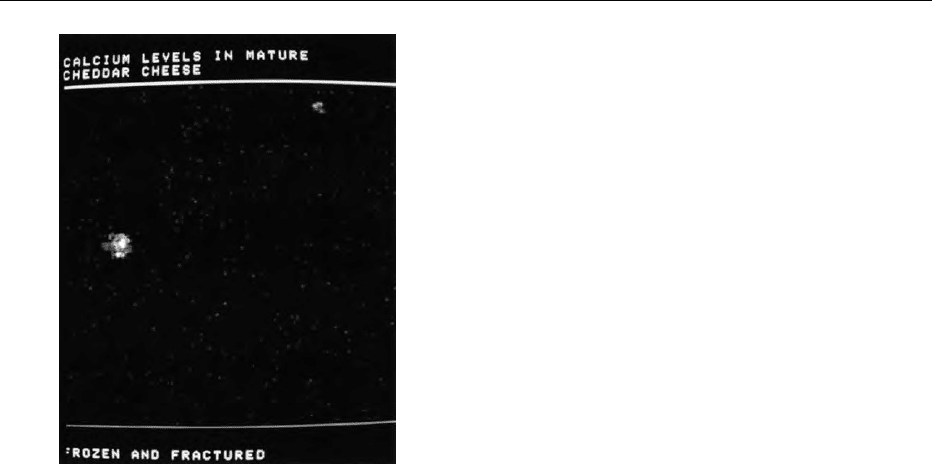
interaction of the electron beam. When any material
with an atomic number of four or more is examined
in an electron microscope, X-rays are generated from
just below the surface. As each element has a unique
X-ray spectrum, the elemental composition can be
determined on the basis of detected X-rays. X-ray
microanalysis systems are of two types: energy-
dispersive X-ray analysis (EDX) and wavelength-
dispersive spectroscopy (WDS). EDX is the more
frequently used technique for biological and food-
type samples. This technique measures the energies
of X-rays and provides analysis of all detectable
elements simultaneously. By contrast, WDS measures
the wavelengths of X-rays with individual crystals,
each of which focuses on one element at a time.
WDS has a better resolution than EDX but is less
easy to use.
0017 In the past, routine EDX detectors have been pro-
tected by beryllium windows that have excluded
transmission of X-rays with an energy of less than
c. 1 kV, i.e., the X-ray energies of elements with an
atomic number below 11 (sodium) and, traditionally,
for the detection of lighter elements, WDS has
been used. However, improved detector design and
the use of plastic windows has enabled the full
range of elements to be detected by routine EDX
systems and WDS is used for specialized analyses.
Through computer interfacing, the X-ray microana-
lytical technique can be used to generate quantitative
data and produce elemental distribution ‘maps’ of
food materials. X-ray mapping techniques have
already provided valuable information relating to
chemical changes in food that have been associated
with their processing, storage, and packaging
(Figure 3).
Cathodoluminescence
0018Certain materials emit long-wavelength photons in
the ultraviolet and visible regions of the spectrum
when they are irradiated with a beam of high-energy
electrons and this phenomenon is termed ‘cathodo-
luminescence.’ Although this technique is widely used
for geological applications, with recent developments
in detector design it has the potential to be applicable
to a wider range of materials, possibly including
foods. Novel treatments could include labeling spe-
cific structures with reagents that exhibit cathodo-
luminescence, much in the same way as fluorescent
labeling is used for light microscopy.
Image Analysis
0019SEM produces electronic/digitized images and as such
they are available for computer manipulation, for
example, in image processing or analysis. Image pro-
cessing involves computer filtration and enhance-
ments to improve the final image quality from the
microscope and this type of facility is often a standard
feature on modern instruments. Image analysis is used
to obtain quantitative data directly from the images,
for example, relating to size and size distribution and
shape of features as well as relative areas and coinci-
dence measurements. Many purpose-built image
analyzers are available commercially with which
analysis of any image source, e.g., objects, photo-
graphs, light microscopy, and TEM images, as well
as SEM images, can be undertaken. The basis for
discrimination of features/areas of black and white
images, such as SEM images, is the difference in gray
levels (differences in black to white) across the image.
SEM images often cause problems because of the very
wide range of gray levels within any one image, al-
though use of high-contrasting techniques, in particu-
lar backscattered imaging, can help eliminate the
problem.
Applications of SEM
0020Many food laboratories have their own scanning elec-
tron microscope or have direct access to one and the
use of the technique is commonplace in the majority
of investigations on food. Applications are many and
diverse, covering practically all of the different food-
stuffs and their ingredients. The strength of SEM in
food studies is its wide magnification range, large
fig0003 Figure 3 (see color plate 108) Digital X-ray map showing
calcium distribution (of calcium phosphate) in frozen hydrated
cheddar cheese.
MICROSCOPY/Scanning Electron Microscopy 3925
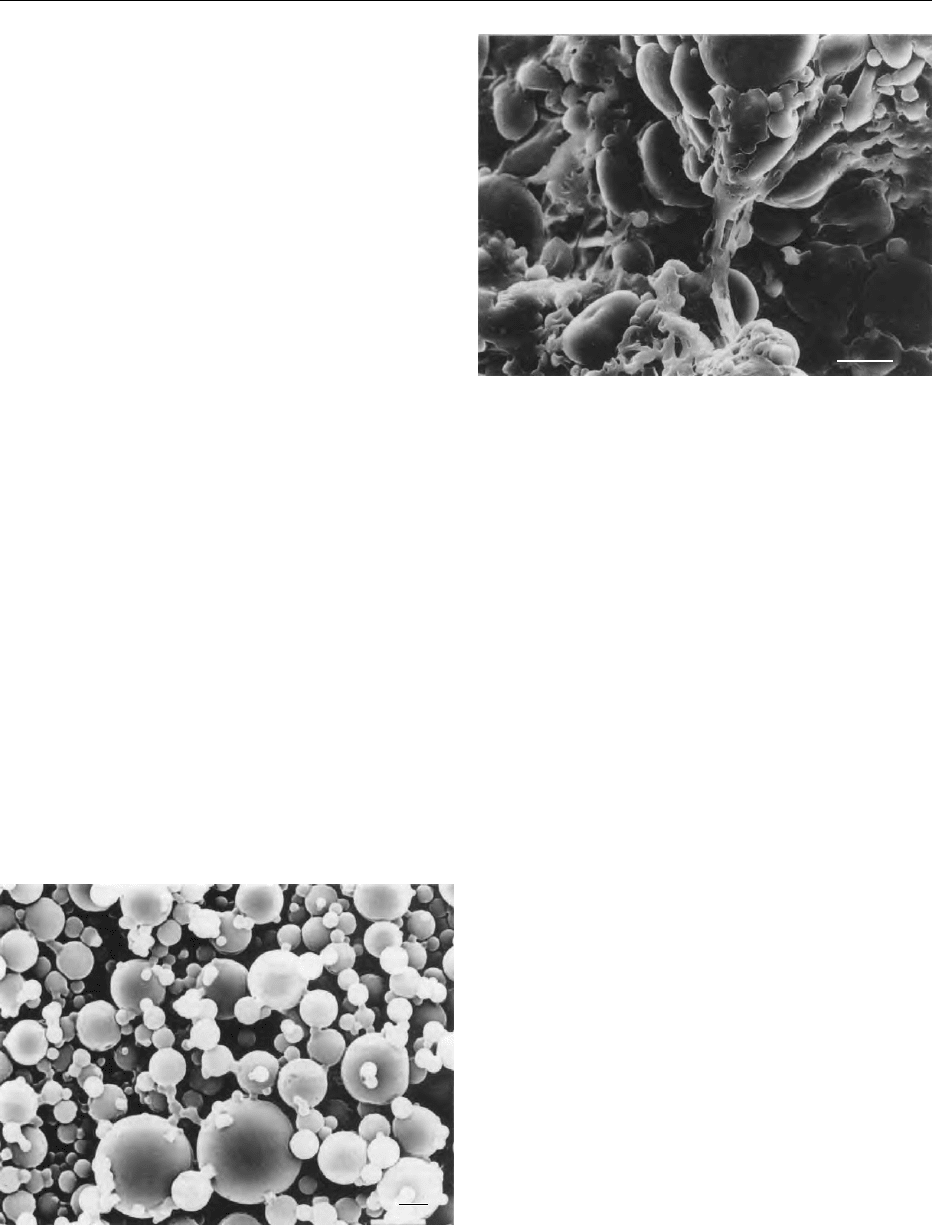
depth of focus, and its ease of use. The relatively
straightforward preparation of dry materials has led
to the extensive use of SEM for the characterization
of powders, for example, spray-dried ingredients
(Figure 4), flour and sugars, as well as dried foods
such as coffees and teas. Comparative information is
obtained on the gross size and shape of the particles
and, by breaking them open, details of the internal
microstructure can be determined, for example the
form and interaction of individual components, in-
cluding crystalline inclusions and air bubbles.
0021 SEM images often provide information that can be
directly related to textural properties of food in a
unique way and can also be related to processing
information as well as sensory panel data. Examin-
ation of different types of bakery products, for
example, can reveal the form of the starch, in particu-
lar the intactness of starch granules together with the
levels of association of the protein strands (Figure 5).
Such detail can often be related to the way in which
the product is likely to break down in the mouth and
explain terms such as ‘crumbly’ or ‘brittle.’ (See
Starch: Structure, Properties, and Determination.)
0022 Many food-manufacturing processes involve pro-
duction of a number of relatively unstable, liquid, or
semisolid intermediate products prior to the finished
commercial sample. SEM, frequently in combination
with low-temperature preparation techniques, pro-
vides a way of monitoring the changes taking place
during the development of the final microstructure
and helps to investigate the effects of different pro-
cessing conditions and/or ingredients. Its use has been
particularly valuable, for example, following crystal-
lization of key food components such as sugar or fat
in different foods, including changes in size and shape
of individual crystalline regions.
0023A significant area of food microscopy is concerned
with the identification of contaminants in food, for
example, fragments of glass, metal, paints or insects,
which are introduced accidentally or deliberately
during and after production. The use of SEM, in
combination with EDX, provides a rapid way of
identifying the composition of contaminants, which
can be quite small (< 1 mm). The technique is non-
invasive and thus the evidence is not destroyed.
(See Contamination of Food.)
Recent Developments and Specialized
SEM Techniques
Low-vacuum and Environmental SEM
0024Although conventional SEMs offering the best
resolution operate at high vacuum, they suffer
from limitations in that the specimens intended for
examination have to be rendered stable, so that
they are able to withstand the vacuum, and elec-
trically conductive. Accomplishing this without
altering the structure is difficult and, clearly, delicate
hydrated or volatile samples often present in food
systems are not vacuum-tolerant. Operation of an
SEM at higher pressures opens up the possibilities of
being able to examine a wide range of vacuum-
intolerant specimens without prior preparation. Not
10 µm
fig0004 Figure 4 Spray-dried particles of polydextrose. Bar ¼10 mm.
Reproduced from Microscopy: Scanning Electron Microscopy.
Encyclopaedia of Food Science, Food Technology and Nutrition,
Macrae R, Robinson RK and Sadler MJ (eds), 1993, Academic
Press.
P
P
S
S
S
P
10 µm
fig0005Figure 5 Fracture through the center of a semisweet biscuit
showing intact starch granules (S) and fine strands of protein (P).
Bar ¼10 mm. Reproduced from Microscopy: Scanning Electron
Microscopy. Encyclopaedia of Food Science, Food Technology and
Nutrition, Macrae R, Robinson RK and Sadler MJ (eds), 1993,
Academic Press.
3926 MICROSCOPY/Scanning Electron Microscopy

only can hydrated and semisolid samples be exam-
ined without prior preparation, the gas ionization
that occurs with increasing pressure in the sample
chamber effectively neutralizes charge that accumu-
lates on the sample and eliminates charging artifact.
The consequence of this is that a conductive layer of
metal does not need to be applied to electrically non-
conductive samples when they are examined at higher
pressures.
0025 SEMs that operate at higher pressures are now
commercially available and are termed low-vacuum
SEMs (LV-SEMs) or variable-pressure SEMs (VP-
SEMs). A further category can provide (in addition
to variable pressures) a saturated water vapor envir-
onment and this is termed environmental SEMs
(ESEMs). All of these achieve their ability to produce
a source of illuminating electrons from normal elec-
tron gun systems whilst maintaining a sample cham-
ber at low (i.e., poor) vacuum by separating different
regions of the instrument by small, pressure-limiting
apertures.
0026 Because they lend themselves to the examination
of nonconductive samples without the need for
coating, LV-SEMs, VP-SEMs, and ESEMs are now
increasingly being used to examine different food
systems. Examples of specimens suitable for examin-
ation with this type of instrument include finished
products and samples taken from different stages of
food processing as well as for the investigation of
complex structures. Novel approaches to the prepar-
ation of samples can yield further information, e.g.,
exposing a lipid-containing matrix, such as a biscuit,
to osmium vapor which will bind to the lipid phase
preferentially and can then be contrasted by back-
scattered electron imaging. Further applications
include samples immunolabeled with gold or silver
probes and also dynamic experiments, such as
following the crystallization of products in an
ESEM.
0027 Demonstration of elemental composition of un-
fixed, uncoated samples by X-ray microanalysis is
possible, although (because of the higher pressure)
the spatial resolution of the X-ray signal is reduced.
However, mathematical corrections have been de-
veloped by some workers and at least one major
manufacturer of X-ray microanalysis systems offers
such algorithms in its software.
High-resolution and Low-voltage SEM
0028 Resolution is largely dependent on the diameter of the
scanning spot of electrons used to examine the speci-
men. However, with decreasing spot size there is
decreasing signal and, with conventional SEMs, the
signal-to-noise ratio becomes unacceptably poor at
very high magnifications. With decreasing accelerat-
ing voltage there is a concomitant decrease in signal
so, traditionally, relatively high (> 20 kV) accelerating
voltages have been used for SEM examination of
specimens. However, reducing the voltage has a
number of advantages. There is a significant reduc-
tion in the build-up of charge and, with reduced beam
penetration, fine detail on the surface of samples is
revealed.
0029With the increasing availability of instruments
equipped with a field emission gun (FEG) and ad-
vanced electron optics, the opportunity now exists
for the examination of specimens with high-intensity
electron beams with small spot sizes over a wide
range of accelerating voltages (including very low
voltage).
0030High-resolution cryo-stages have been developed
to complement this range of FEG-SEMs so that frozen
samples can be examined at high resolution. There is
now considerable overlap between the information
that can be obtained from fractured frozen samples
examined by high-resolution SEM and that obtained
from traditional freeze-fracture studies made by
TEM. Often, larger areas of a sample are available
for examination by SEM, when compared with
complementary TEM freeze-fracture studies, and
interpretation of the results can be less difficult. How-
ever, in both cases, the quality of freezing is para-
mount and normally it is only a small region close
to the edge of a sample that will have been frozen
sufficiently rapidly to be comparatively free of ice
crystal artifact.
0031Applications that are particularly suitable for
examination with such instrumentation include
emulsions, foams, liposomes, microorganisms, and
food systems where interfaces are of interest.
0032There is an additional category of instruments
(ESEM-FEG) that exists that combines the ability to
operate at high resolution and high gun intensity with
the capability of operating at higher pressures and
relative humidity. These instruments offer an enor-
mous range of different operating modes to suit dif-
ferent sample types. However, this flexibility comes at
a price and the principal limitation is the cost of
purchase.
Specimen Preparation
0033Significant improvements have been made in both
instrumentation and electronics in SEM over recent
years. In applying the technique more widely to
food studies, however, the limitations probably still
lie in the area of presentation/preservation of the
specimen to insure that the microstructure is retained
in its original form when examined by SEM. It is
MICROSCOPY/Scanning Electron Microscopy 3927

this area of the technique where most developments
are likely, particularly in the use of environmental or
LV-SEM or VP-SEM, low-temperature preparation
procedures, and also in high-resolution cryogenic
techniques.
0034 When the first scanning electron microscopes were
available commercially, the appeal of a three-dimen-
sional image led to the rapid production of numerous
micrographs of food materials with perhaps only
limited scientific value. Now that this period is over,
an increasing number of workers are using the fuller
potential of SEM and it has emerged as an important
research tool both in its own right and as a comple-
mentary technique to other microscopical techniques
in microstructural investigations of food and food
processing.
See also: Analysis of Food; Contamination of Food;
Starch: Structure, Properties, and Determination
Further Reading
Cohen SH (1984) Scanning electron microscopy in the
analysis of food microstructure: a review. In: Charalam-
bous G (ed) Analysis of Foods and Beverages: Modern
Techniques, pp. 421–449. Orlando: Academic Press.
Goldstein JI, Newbury DE, Echlin P, Joy DC, Fiori C and
Lifshin E (eds) (1992) Scanning Electron Microscopy
and X-ray Microanalysis. New York: Plenum.
Heathcock JF(1988) Cryotechniques in the examination of
food. Institute of Physics Conference Series no. 93 3(2):
55–57.
Holcomb DN and Kalab M (eds) (1981) Studies of Food
Microstructure. Scanning Electron Microscopy.
Chicago, USA: AMF O’Hare.
Kalab M (1983) Electron microscopy of foods. In: Peleg M
and Bagley EB (eds) Physical Properties of Food, pp.
43–94. Westport: AVI.
Sargent JA (1988) Low temperature scanning electron
microscopy: advantages and disadvantages. Scanning
Microscopy 2: 835–949.
Transmission Electron
Microscopy
J H Holgate and J Webb, Reading Scientific Services
Ltd, Whiteknights, Reading, UK
Copyright 2003, Elsevier Science Ltd. All Rights Reserved.
Introduction
0001 Many investigators have studied the textural behav-
ior of numerous products using physical measure-
ments and showed good correlation with sensory
evaluations of texture and mouth feel. Microstruc-
tural analysis now seems to be playing a key role in
explaining the type of data produced. It is being used
increasingly in the study of a wide range of food
products and ingredients, with the data obtained
being related to a sample’s textural properties and in
some cases to its perceived flavor. Such studies can
help in the overall understanding of the effects of food
processing. (See Analysis of Food; Sensory Evalu-
ation: Sensory Characteristics of Human Foods.)
0002The first commercial transmission electron micro-
scope was available in the 1940s when it was recog-
nized that significant improvements in resolution
could be made over the light microscope through the
use of an electron beam rather than a light beam.
However, the instrument could only operate under
vacuum and required ultrathin specimens for the
beam to pass through. Thus, specialized preparation
techniques had to be developed to insure that micro-
structural and ultrastructural details of specimens
were adequately preserved during each of the pre-
parative stages.
0003In the early years, the application of transmission
electron microscopy (TEM) to the food industry
lagged behind that in metallurgical and biological
fields. This was partly due to problems in specimen
preparation and handling that were specific to food
materials, arising from the lack of homogeneity and
often the presence of high levels of water, sugars, or
fats.
Principles
0004A hairpin tungsten filament of an electron gun, en-
cased in a column at high vacuum, is heated to gener-
ate a cloud of electrons, which is accelerated through
a hole in an anode to produce a narrow beam that is
directed towards the specimen. By using electromag-
netic lenses to focus the resultant beam, an image can
be formed by projecting the electron beam through a
thin specimen. The first instruments produced magni-
fications up to 10 000 but subsequent development
of electromagnetic lens systems and guns capable
of accelerating voltages exceeding 100 kV and up
to 400 kV on standard TEMs has extended the
magnification range up to 1 000 000 or more,
with resolutions of better than 0.2 nm possible on
modern instruments. As the human eye is not sensi-
tive to electrons, the final image is visualized by being
focused on to a fluorescent screen or directly on to a
photographic plate or film.
0005TEM operates under high vacuum (< 10
5
mm Hg
or < 10
4
Pa) in order to minimize the scattering of
the electron beam by gas molecules and allow it to
3928 MICROSCOPY/Transmission Electron Microscopy

travel through the microscope without contamin-
ation. This brings with it the physical problems of
having a specimen which must withstand exposure
to high-vacuum as well as high-voltage electron
beams.
Preparation Techniques
0006 A number of different techniques are available for
the preparation of specimens for TEM. The choice
depends very much on the nature of the food, for
example, whether it is liquid or solid or whether it
contains high levels of water, fats, or sugars, which
may make it difficult to handle during the various
preparative stages. In all cases, however, the basic
requirement is to produce an ultrathin preparation
that allows an electron beam to pass through it,
whilst at the same time being dry and resistant to
the high vacuum and potential high temperature of
a high-voltage beam.
0007 Food often presents particular difficulties because
of its heterogeneity and, in many cases, the presence
of relatively high levels of fats and sugars, often in
combination.
0008 The most frequently used TEM preparation tech-
niques that have been applied fairly successfully to
different food materials are negative staining, thin
sectioning, and freeze-fracture replication, with the
latter two being used most often.
Negative Staining
0009 Negative staining represents one of the easier and
more rapid techniques in terms of specimen prepar-
ation but is limited in food applications to studies of
dilute suspensions or dispersions, for example, food
proteins, liposomes, cellular fragments, liquid crys-
tals, or microorganisms. It cannot be used for large
or more complex food systems.
0010 In this technique the particulate or colloidal com-
ponents are examined directly on a TEM specimen
support grid after they have been surrounded or
embedded in an electron-dense ‘stain.’ The technique
relies on the metallic stain producing an outline of the
structures, rather than reacting positively with them,
thus providing information on overall size and shape
and detail of features such as bacterial flagella. Phos-
photungstic acid (PTA) is one of the negative stains
used most commonly (Figure 1), although some
success has been achieved with uranyl acetate, par-
ticularly for the examination of food protein
macromolecules. A third reagent, ammonium molyb-
date, has been used, but with less predictable results,
and has been shown to be particularly sensitive to
localized pH changes.
0011There was a renewed interest in the use of negative
staining in the mid 1980s as it became possible to use
it in combination with low-temperature TEM prepar-
ation techniques. Fully hydrated, negatively stained
preparations are fast-frozen and then examined by
TEM on a low-temperature (below 150
C) stage.
This approach has been particularly successful in the
examination of viruses and single-cell preparations,
but has been of limited use to date in studying food
components.
Thin Sectioning
0012Probably the most frequently used preparation
procedure for TEM is thin sectioning, where the
specimen is initially preserved chemically or ‘fixed,’
solvent-dehydrated, and then infiltrated and embed-
ded in a resin or other polymeric material. On poly-
merization (usually by high-temperature curing), the
resin hardens so that ultrathin slices or sections
(< 100 nm) of the embedded material can be cut
using an ultramicrotome.
0013Among the various chemical fixatives currently in
use, glutaraldehyde, followed by osmium tetroxide
(O
S
O
4
), remains one of the most effective. However,
a number of different fixative regimes have been
developed for different food systems, often involving
alternative aldehydes or mixtures of aldehydes and
using temperatures, osmolarities, pH values, and
buffers appropriate to the food. Osmium textroxide
has the advantage of being uniquely suitable for fats
and thus has been used particularly for foods contain-
ing high levels of fat (e.g., oil seeds, emulsions,
chocolate). It also functions in its vapor form and,
therefore, is useful as a primary fixative to stabilize
the specimen prior to further treatment. As well as
fixing the sample, chemical bonding of the osmium to
the unsaturated fats produces electron-dense ‘stained’
regions in the preparations. Extended fixation times
are often employed for fatty foods, although these are
often a compromise, as they have sometimes been
shown to produce artifacts in the nonfat areas of the
specimen.
0014Many different types of polymers have been used as
embedding materials over recent years. Epoxy resins
andmethacrylates areperhapsusedmost frequentlyfor
food materials, particularly lower-viscosity polymers.
A number of different resins were developed during
the 1970s and 1980s. Initially they offered particular
advantages of very low viscosity, and thus more rapid
and efficient infiltration, and were thought to be safer
to handle. Unfortunately, a number of the compon-
ents of the resins were still found to be unsafe, having
carcinogenic properties in particular. However, a
range of new acrylates became available in the
1990s, which are not only considered safer to handle
MICROSCOPY/Transmission Electron Microscopy 3929
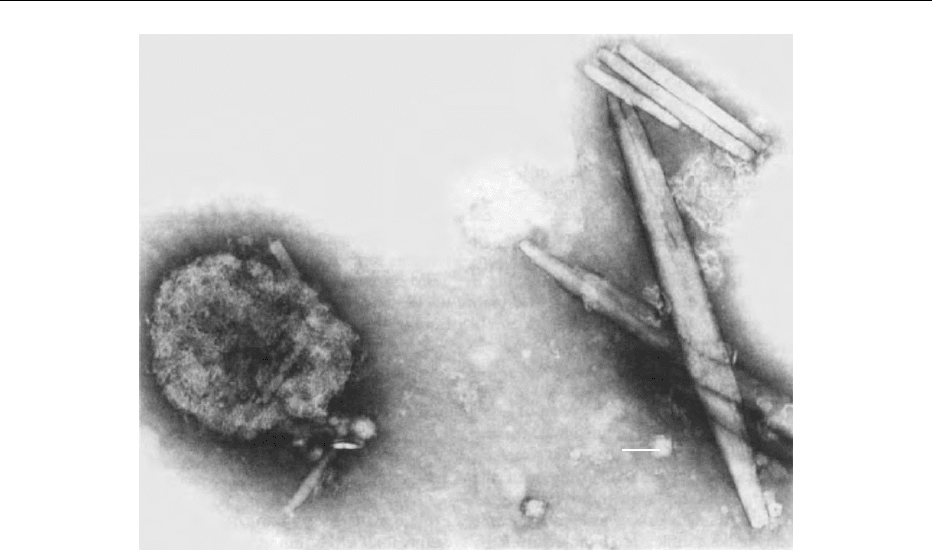
but have relatively low viscosities. Some of these can
be polymerized at low temperatures by ultraviolet
curing, though care has to be taken to prevent local-
ized heat build-up as the accelerator is activated.
Thus, the problems of exposing materials to high-
temperature polymerization conditions are avoided.
Other polymeric materials available are miscible with
water and thus eliminate the solvent dehydration
stages. However, these have been of only limited use
as they often produce fairly brittle embedded blocks,
which are difficult to section.
0015 When food samples are in liquid or semisolid form,
there is obviously a special requirement to keep the
sample intact during the various preparative steps.
This is achieved by some means of encapsulation
and a number of workers have used a modification
of the Salyaev technique with considerable success in
preparing milks, fruit juices, cell suspensions, and
other liquid food materials. The principle is to
prepare a capillary tube of agar that is filled with
the sample and sealed at both ends with further
agar, before being put into liquid fixative and pro-
cessed as for other materials.
0016 The embedded materials, usually in the shape
of small tubes or blocks, are sectioned using an
ultramicrotome to produce ribbons of ultrathin
sections measuring between 50 and 100 nm. Trad-
itionally, freshly cleaved glass knives are used as
they have very sharp cutting faces. However, dia-
mond knives have increased in popularity over recent
years, as they remain sharp for extended periods of
time and thus are suited to hard materials, e.g.,
woody tissue, bone, and crystalline components.
Their main disadvantage is price, including the high
cost of resharpening.
0017Cut sections are collected on meshed support grids
designed to fit the TEM holders and then examined in
the microscope, usually after staining to enhance the
contrast of the sample and specifically identify
individual components. Contrast in a TEM image is
a result of differential electron opacity and therefore
the most effective stains are based on reaction with
electron-dense materials, in particular those with
the highest atomic numbers, e.g., inorganic stains
containing heavy metals.
0018Traditionally, staining has involved an initial reac-
tion with uranyl acetate followed by lead citrate to
provide a fairly nonspecific staining of the whole
sample. This approach is still used routinely for
many food specimens, with subsequent identification
of components based mainly on their characteristic
morphological features rather than their reaction to
H
H
V
100 nm
fig0001 Figure 1 Negatively stained preparation of material isolated from a comminuted fruit drink showing the presence of hesperidin
crystals (H), chromoplasts (C), and membraneous vesicles (V). Bar ¼100 nm. Reproduced from Microscopy: Transmission Electron
Microscopy, Encyclopaedia of Food Science, Food Technology and Nutrition, Macrae R, Robinson RK and Sadler MJ (eds), 1993, Academic
Press.
3930 MICROSCOPY/Transmission Electron Microscopy
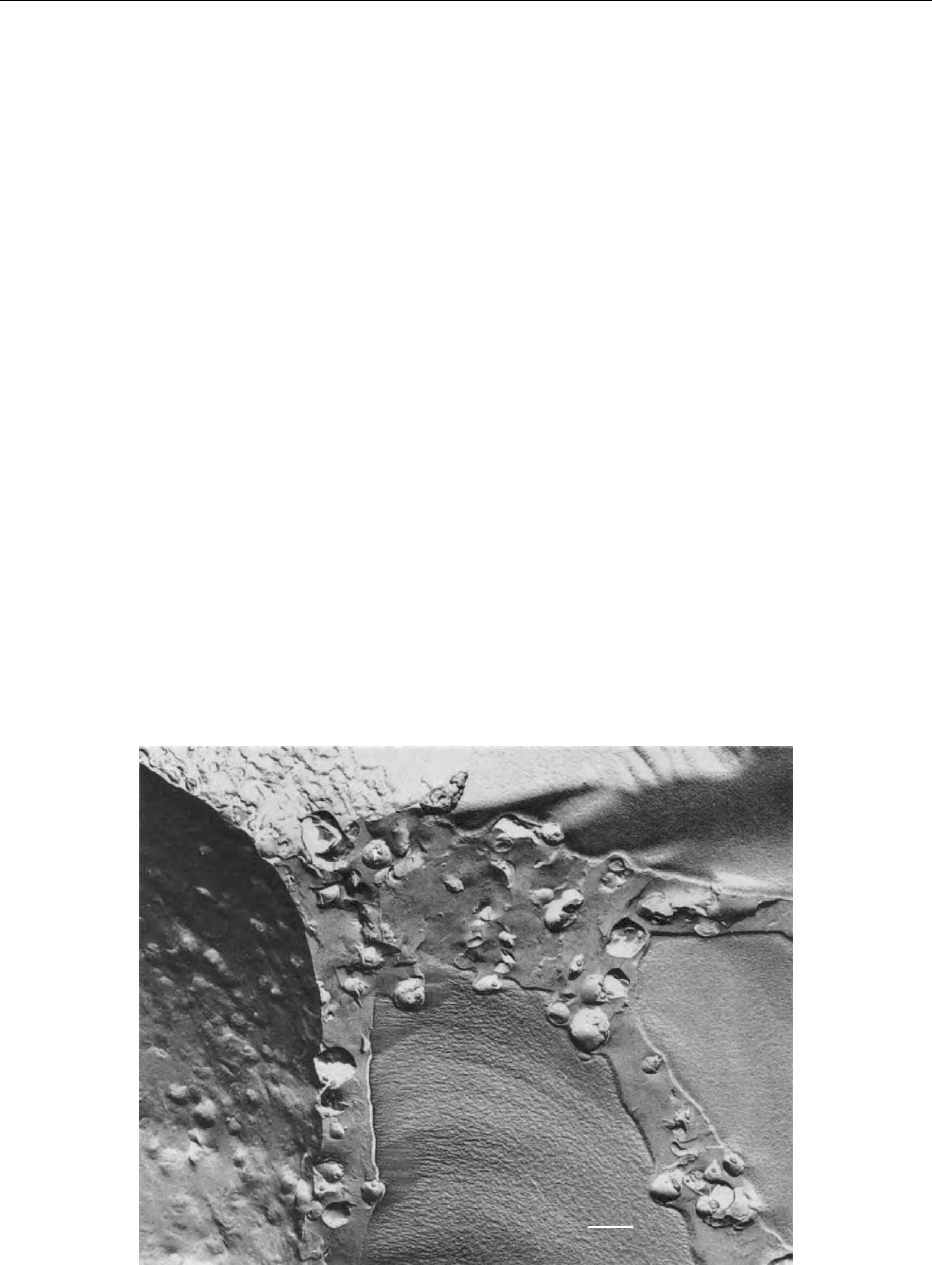
stain. However, many different staining regimes have
been developed for specific components, e.g. proteins,
carbohydrates, and polysaccharides, in a wide range
of different foods. Frequently these have been based
on traditional biochemical reactions, but for TEM the
staining compound includes a heavy-metal salt rather
than a chromophore (coloured moiety). (See Carbo-
hydrates: Determination; Protein: Determination and
Characterization.)
Low-Temperature Preparation
Techniques
0019 For specimens which contain high levels of water or
which are liable to change significantly during fix-
ation or embedding procedures, preservation of the
ultrastructure can be achieved with a cryofixation
step, i.e., rapid freezing of small samples. This
preserves the natural three-dimensional structure
and solidifies the material so that it can subsequently
be sectioned or fractured to reveal its internal
structure.
Cryosectioning
0020 Cryosectioning (sectioning at low temperatures)
of frozen materials can be used for biological and
biomedical tissues. It involves the controlled
sectioning of frozen material using an ultramicrotome
at low temperatures. Sections can be examined dir-
ectly on a low-temperature TEM stage or after freeze-
drying. However, there are few published data on the
successful application of this technique to foods be-
cause of the difficulty of cutting ultrathin frozen
sections of food materials and handling them prior
to examination.
Freeze-Fracture/Freeze-Etch Replication
0021The alternative to sectioning frozen material is to
fracture the sample and reveal its internal structure.
Combining freeze-fracture with metal shadowing/
carbon replication techniques has proved a par-
ticularly useful procedure for preparing many differ-
ent foods for TEM, including emulsions, foams, and
fatty confectionery, as well as frozen products such
as icecream (Figure 2). This procedure is referred to
as freeze-fracture or freeze-etch replication. One
of the critical stages in the procedure is achieving
rapid and efficient freezing of the sample to prevent
the formation of visible ice crystals or other arti-
facts and considerable efforts have been made to
optimize this process. Nitrogen ‘slush,’ i.e., a mix of
liquid and solid nitrogen (210
C), is probably the
I
I
A
1 µm
fig0002 Figure 2 Freeze-etch preparation of icecream showing the presence of ice crystals (I), air bubbles (A), and fat droplets (F) within an
aqueous sugar matrix. Bar ¼1 mm. Reproduced from Microscopy: Transmission Electron Microscopy, Encyclopaedia of Food Science,
Food Technology and Nutrition, Macrae R, Robinson RK and Sadler MJ (eds), 1993, Academic Press.
MICROSCOPY/Transmission Electron Microscopy 3931

most frequently used cryogen, as it is relatively easy
to prepare and use. However, faster freezing rates
are possible with liquid propane and hexane and
these are now being used increasingly, particularly
in combination with purpose-built freezing appar-
atus that are designed to enable safe handling of
these flammable materials. Commercial develop-
ments in this field include specialized apparatus
for cold metal block freezing (‘slamming’) and
spray jet freezing. However, these are relatively
expensive and have been of limited application in
food microscopy.
0022 Some success has been achieved with the use of
cryoprotectants, for example glycerol, which can be
used to infiltrate TEM specimens and inhibit the
development of ice crystals on freezing. However,
the interaction of the chemical has been shown to
change the fine structure of samples and is now used
more as a complementary technique in low-tempera-
ture preparations. Certain foods have been shown to
offer an advantage in achieving fast freezing as they
provide their own cryoprotection with the presence of
high levels of sugars or salts.
0023 Once the frozen samples are transferred on to
the cold stage of a freeze-fracture/etch unit, they are
fractured under vacuum and a carbon/platinum
replica is prepared of the frozen fractured
surface. Replication is achieved by the evaporation
of a thin supporting layer of carbon followed by
platinum deposited at an angle to produce a ‘shadow’
and hence reveal the topographical details of the
surface.
0024 For samples with high levels of water present,
‘freeze-etched’ replicas are made by the sublimation
or ‘etching’ of a thin layer of surface ice before
replication. After replication, samples are removed
from the unit and the replicas are then cleaned in
detergent and/or solvents to remove the food sub-
strate before TEM examination. The choice of
cleaning regime is important in order to clean the
replica adequately whilst at the same time preserving
its integrity. Strong caustic solutions have proved
useful for many food materials, often combined
with detergent or organic solvent washes to remove
the fatty components.
Freeze Substitution
0025 Freeze substitution involves the replacement of water
(ice) in a frozen preparation with an organic solvent
and subsequently with resin. There has been renewed
interest in the technique recently because of its
suitability for preparing biological tissues for
immunolabeling. However, it is still of only limited
application to food materials.
TEM Attachments
Scanning Unit
0026Many modern TEMs have the facility for attachment of
a scanning unit to the main instrument. The unit allows
the beam to be scanned across a selected area of the
specimen and with the addition of suitable detectors
the electron microscope can be used in a surface
imaging mode or in a scanned transmission mode
(STEM). In surface imaging mode, high-resolution
images of the surface of samples can be obtained,
although the small sample chamber restricts the size
of sample that can be examined. The primary applica-
tion of STEM is in imaging thicker samples. Since the
images produced are electronic/digital, they have the
advantage that they can be subjected to image process-
ing and analysis to enhance the information further.
X-ray Microanalysis
0027Interaction of an electron beam with a specimen
produces X-rays which are characteristic of its elem-
ental composition. These X-rays can be collected to
provide qualitative and quantitative chemical data
from a sample. The technique is applicable to both
transmission and scanning electron microscopes and
is dealt with in more detail in the preceding article
Microscopy: Scanning Electron Microscopy. In TEM
its main application is in determining the distribution
and changes in distribution of specific elements
within thin-sectioned preparations. It has been of
limited value for food samples to date, as the fixation
and embedding techniques required for adequate pre-
servation of microstructure frequently result in redis-
tribution of elements within the material.
Applications of TEM
0028Many different food materials have now been exam-
ined using TEM. However, its main use has been in
terms of characterizing the ultrastructure of different
foods and relating this information to process changes
and to textural and other physicochemical properties.
Early studies involved the use of thin-sectioning tech-
niques on foods with relatively high levels of plant or
animal tissue, for example, meat, fruit, and vege-
tables. These studies were able to demonstrate the
cellular changes associated with processing and
cooking fresh tissue and included the use of specific
staining regimes to monitor chemical changes such as
the integrity of plant cell walls, meat fibrils, etc. More
recent studies tend to use a combination of micro-
scopy techniques to study the changes in more detail
and to characterize more complex, composite mater-
ials, such as many confectionery products (Figure 3).
3932 MICROSCOPY/Transmission Electron Microscopy
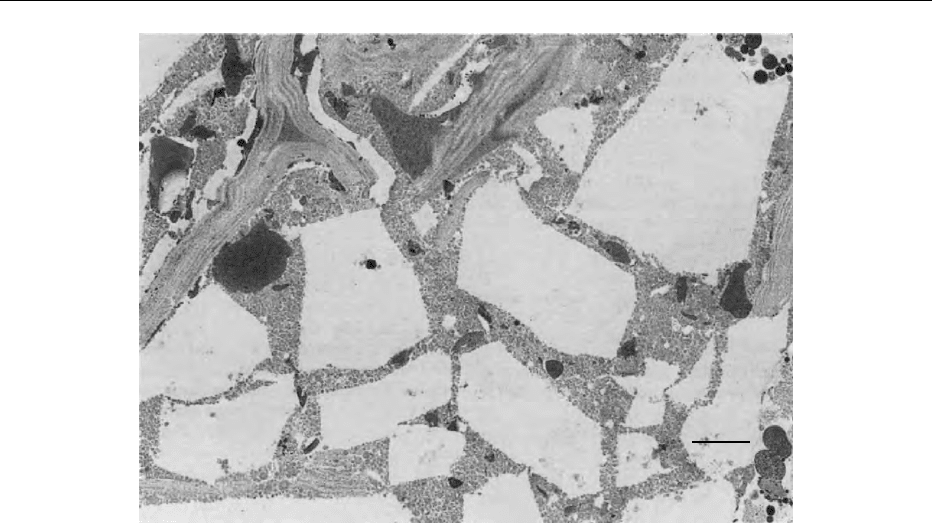
0029 Studies on liquid or semisolid foods, for example,
milk, emulsions, and fruit beverages, have increased
significantly with the introduction of low-temperature
techniques for handling and preparing these types of
material. It has been possible, therefore, to identify
and characterize the individual components present,
for example, size and shape of fat droplets, form and
level of aggregation of proteins (Figure 4), and to
evaluate changes arising as a result of processes
(heat, shear, pH changes, etc.), ingredients (different
fats, protein source, etc.) or recipes.
0030 The use of TEM for examining dry materials, for
example milk powders, has been mainly superseded
by the introduction of scanning electron microscopy
techniques. However, it has been found that the use of
thin sectioning, and more especially carbon replica-
tion techniques for TEM, has produced valuable
information on the ultrastructural detail of these ma-
terials, in particular, the location and appearance of
protein, which was not possible in any other way.
Future Developments in TEM of Food
Materials
Immunolabeling
0031 Colloidal gold immunolabeling is now probably the
most highly acclaimed technique for electron immu-
nocytochemistry. Gold spheres, bound to selected
antibodies, are incubated with the relevant receptor
to effect high-resolution and highly specific labeling.
The technique is now enhanced by application of
multiple labeling of different antigens using differ-
ent-sized gold particles and quantitative techniques.
However, it has yet to be used extensively for food
materials. This is due to the problems of raising
and isolating antibodies specific to food components,
particularly after the foods have been processed,
combined with the overall difficulties in handling
food for TEM.
Low-Temperature Preparation Techniques
0032The use of low-temperature preparation procedures
has increased significantly over the last few years.
However, considerable advances have been made in
faster freezing methods, alternative ways of handling
frozen materials, e.g., sectioning, complementary
fracturing techniques, and combinations of fractur-
ing/sectioning/labeling, which have mainly been
applied to nonfood materials. It is likely that these
will be applied increasingly to studies on food.
Scanning Probe Microscopy (SPM)
0033This is a developing field and the techniques relevant
to the microscopy of foods are centered on using
scanning tunneling microscopes (STM) and atomic
force microscopes (AFM). They provide high-
resolution visualization of surface morphology and
S
S
P
C
C
S
2 µm
fig0003 Figure 3 Thin section of milk chocolate showing the close association of milk protein (P), sugar (S), and cocoa tissue (C) within a
chocolate particle. Bar ¼2 mm. Reproduced from Microscopy: Transmission Electron Microscopy, Encyclopaedia of Food Science, Food
Technology and Nutrition, Macrae R, Robinson RK and Sadler MJ (eds), 1993, Academic Press.
MICROSCOPY/Transmission Electron Microscopy 3933
